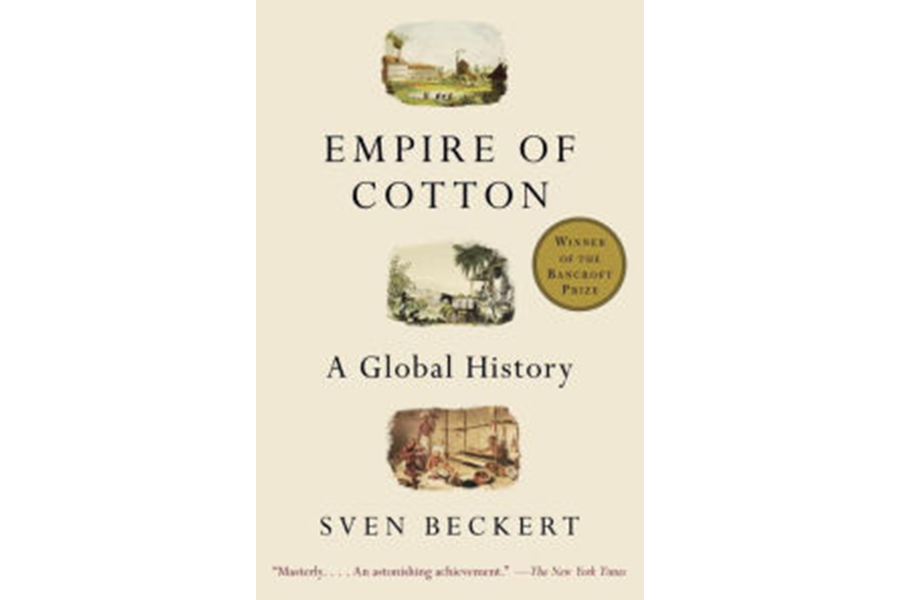The history of cotton: enormous exploitation, violence, and coercion
Loading...
Think of capitalism. What comes to mind? Banks, international markets and manufacturers. Rich executives and not-so-rich workers. Consumers, retail stores and buy-buy-buy. In other words: cotton.
Yes, the fluffy stuff that lurks in our clothes, sheets, and towels. And elsewhere too: our money and our mattresses, our books and our coffee filters, and even our explosives.
Cotton is a very big business, and it’s been that way in the Western world for centuries. As Harvard University history professor Sven Beckert explains in his 2014 book Empire of Cotton: A Global History, we can peer through cotton’s past and – for better and worse – find the roots of our modern economy.
“Empire of Cotton,” a Pulitzer Prize finalist that won the Bancroft Prize, is newly out in paperback. In a Monitor interview, Beckert talks about the rise of cotton, the role of slavery, and the revolution in productivity that drives our economy today.
“Cotton is clearly a story of enormous exploitation, violence and coercion,” he says. “But there’s also another story.”
Q: How did you get interested in the history of cotton in the first place? Did you come across some 300-thread-count percale sheets at a luxury hotel and start asking questions?
I didn’t know much about cotton, but I wanted to write a book that puts the history of the United States into a global perspective and looks at the long history of capitalism.
Cotton is really a way to look at something real, a material that connects many parts of the world to one another. I can follow the fiber, follow the cotton wherever it takes me.
And thus I was able to write a book that connects distant places of the world to one another and illuminates the connections between the histories of peasants, slaves, sharecroppers, merchants, industrial workers, manufacturers, and consumers all across the globe.
Q: How did cotton become such a huge product?
For about 1,000 years, cotton was the dominant fiber used to produce clothing in the world, predominant in most of Asia, Africa, and Latin America. But the exceptional story is that it was actually an exotic fiber in the European continent, a luxury product that few Europeans could afford.
It was only in the 19th century that cotton became commonly used in Europe. Once it arrived at cheap prices, it revolutionized how Europeans dressed and kept clean.
Previously, they’d spun linen and wool. But cotton is easier to be cleaned, color can be applied much more easily, and it’s more pleasant to wear on the skin. And cotton, eventually, became much cheaper to produce.
Q: Why did the growing of cotton become such an international issue?
Cotton doesn’t grow in Europe except in very small areas. By the 18th century, the most important source was the Caribbean and Brazil, and then it came to the United States.
Cotton was central to the slave economy and the position of the US in the global economy. At the beginning of the Civil War, cotton was the most significant export of the United States, accounting for approximately 60 percent of all exports.
Q: Was cotton as big of a deal then as oil is now?
Cotton was the industrial world’s most important raw material, and in the 19th century was almost as important as oil was in the 20th century to the development of capitalism.
It was a catalyst for bad behavior: Cotton is clearly a story of enormous exploitation, violence, and coercion. But there’s also another story.
With the technical changes brought about by the industrial revolution, it suddenly became cheaper to produce vast quantities of cotton textiles, an unprecedented increase in human productivity. Certainly everything about our lives today is based on this enormous revolution.
Q: What does cotton and its production mean to us today?
We still consume an enormous quantity of cotton products. You find cotton in bank notes, coffee filters, gunpowder, diapers – all kinds of places that you might expect. It’s all around us, not just in our clothing.
But the cotton is not mostly grown in the United States. Historically, the cotton industry originated in South Asia, and in the past 50 years, that industry has almost completely returned to the Asian continent. The most important grower is China, followed by India and other Central Asian nations.
Q: What lessons can we take from the history of cotton as we try to cope with – and maybe improve – modern capitalism?
The most important lesson is the insight that capitalism is not a state of nature, but has a history, even a very long history, and that it looks very different in different places and at different moments in time.
Since capitalism is historical, its precise shape is very much the result of human actions. Capitalism can be shaped in various ways, for better and for worse. States, and thus politics, plays an exceedingly important role in this shaping.
Q: What should we think the next time we put on a cotton shirt, slide into cotton sheets, or dry ourselves with a cotton towel?
We should pause to think of the amazing chain of people and places that have been involved in its production: The children who might have pulled the cotton boll from the plant in Uzbekistan, the giant Chinese mills that spun and wove the fiber, and the ill-paid workers who made it into clothing.
In some ways, a T-shirt should be an awe-inspiring object. But as consumers and as citizens, it should make us aware of our complicity in things that we would probably not want to be responsible for.
Randy Dotinga, a Monitor contributor, is president of the American Society of Journalists and Authors.







